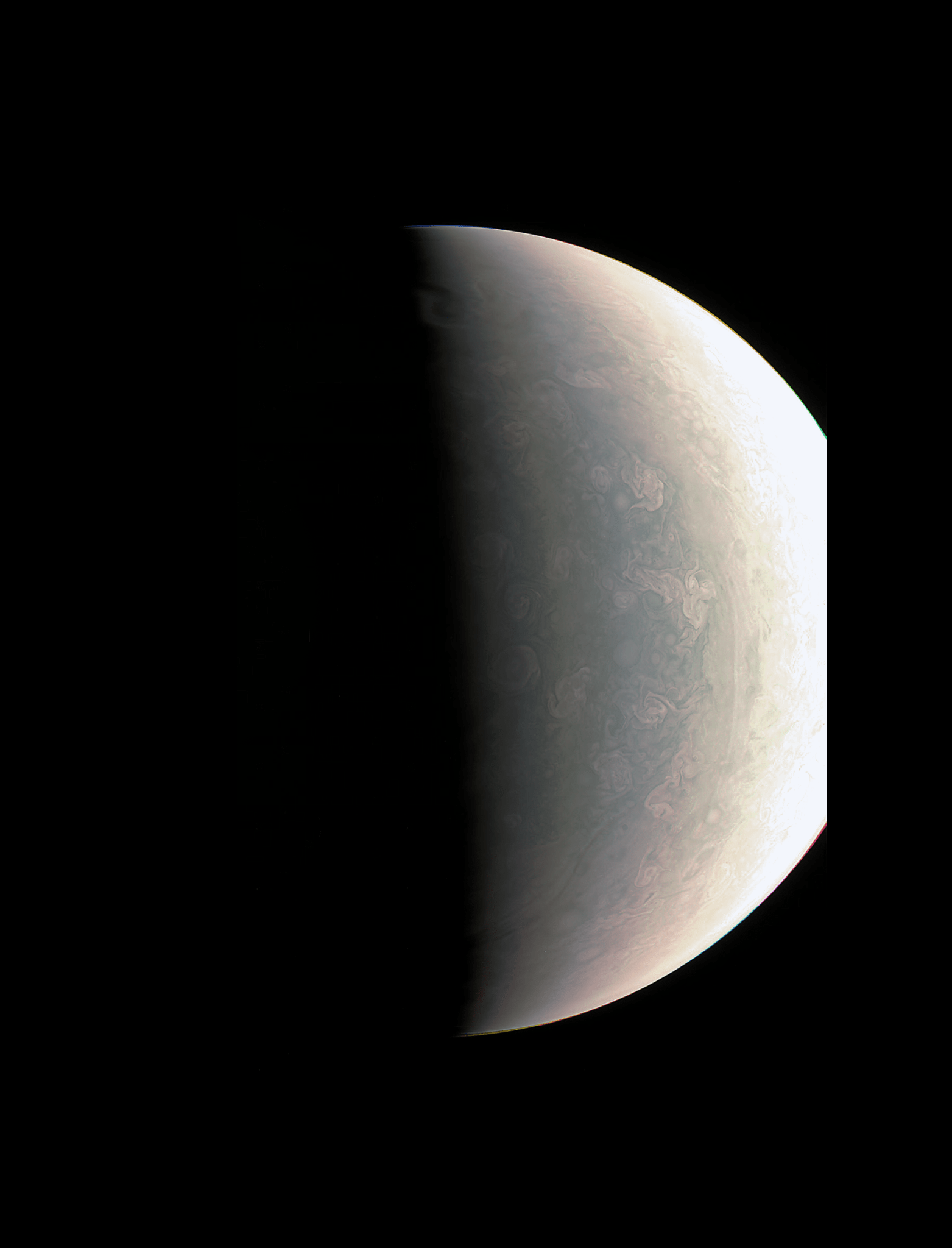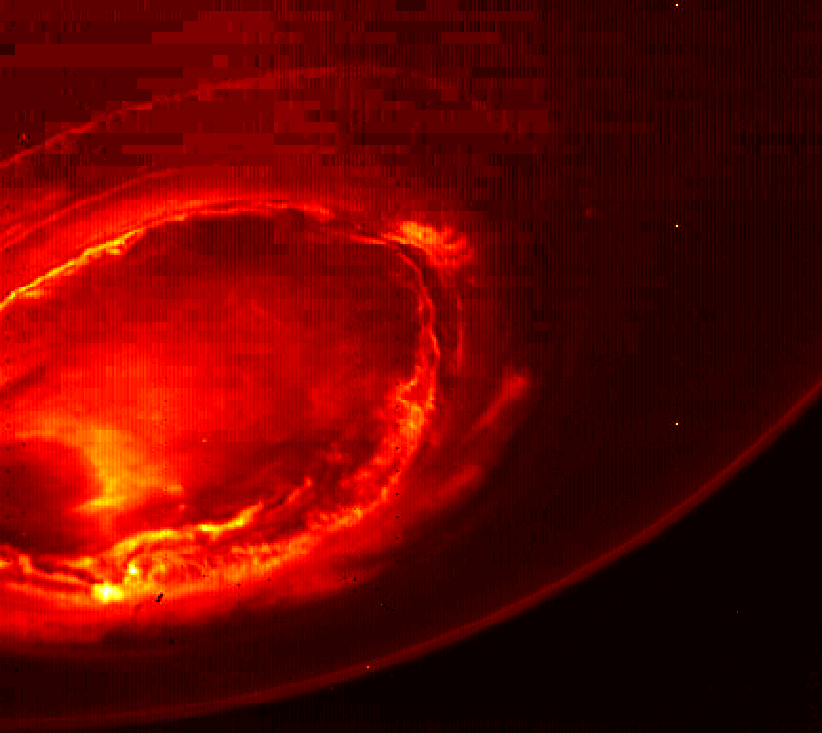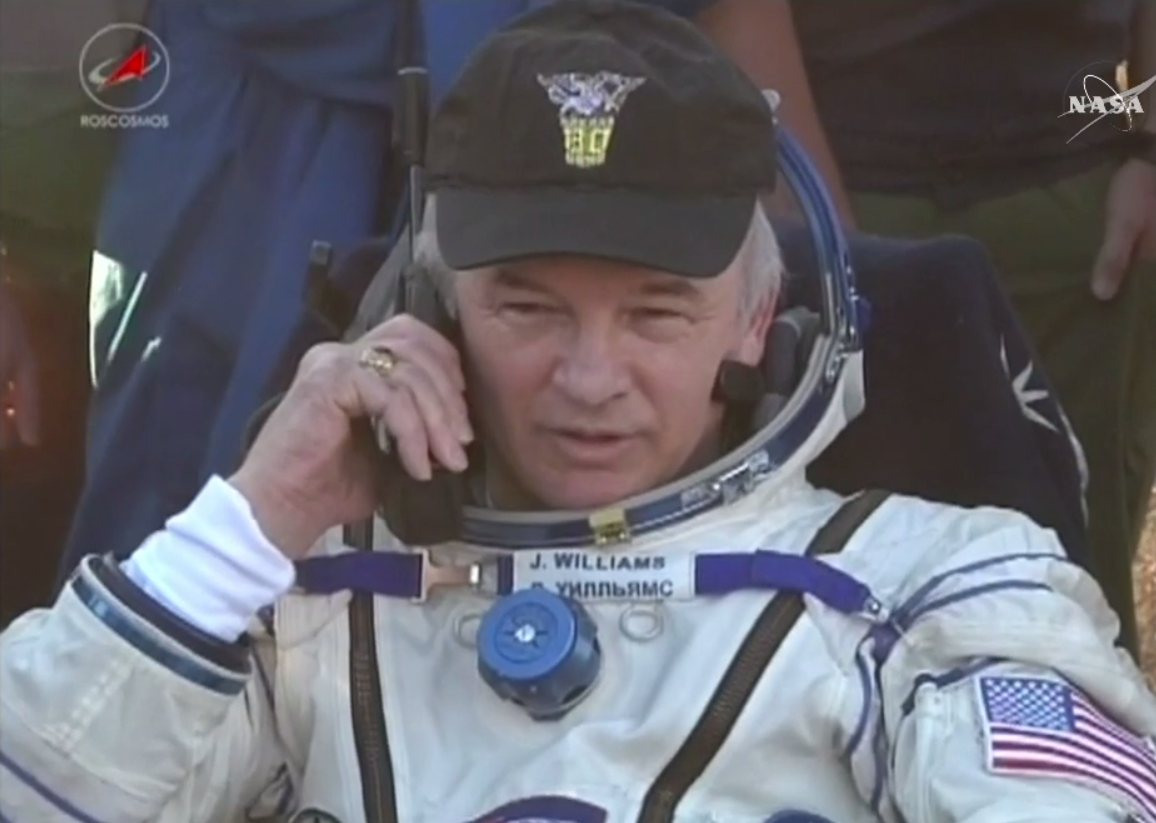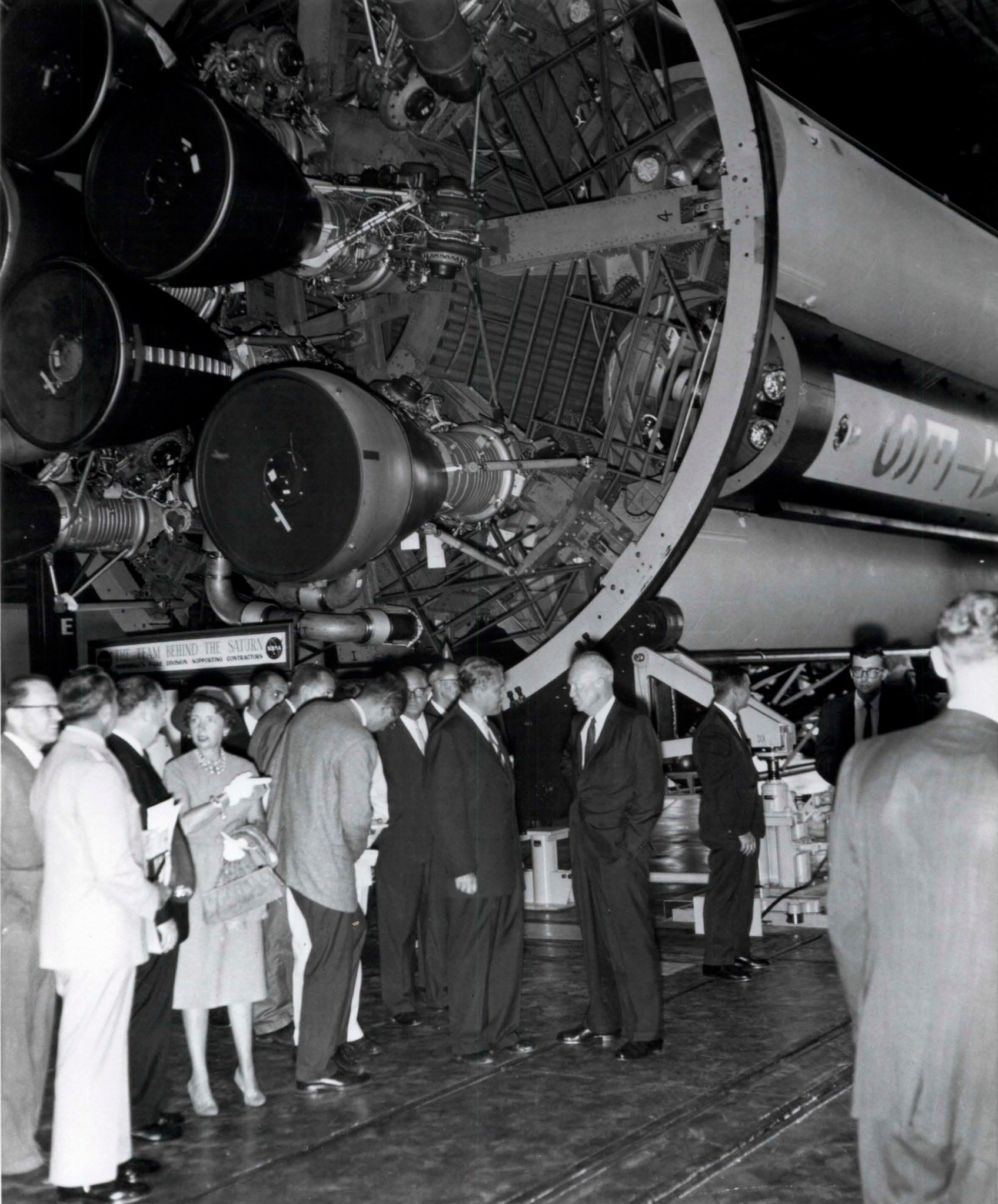In This Week’s Star
- NASA Tests New Insulation for SLS Rocket
- Jupiter’s North Pole Unlike Anything Encountered in Solar System
- NASA Approves 2018 Launch of Mars InSight Mission
- NASA’s Record-breaking Astronaut, Crewmates Safely Return to Earth
- Four Questions with OSIRIS-REx Mission Manager Scott Bellamy
- NASA Celebrates 50th Anniversary of Original Star Trek TV Series
- This Week in NASA History: President Eisenhower Formally Dedicates Marshall Center — Sept. 8, 1960
- A New Galaxy, Jupiter Images and New Horizons Updates are Featured on ‘This Week @NASA’
- Obituaries
NASA Tests New Insulation for SLS Rocket
By Megan Davidson
You may not think about insulation much, but it’s one of those unsung industry heroes that keeps our drinks cold and homes warm on those bone-chilling winter days. Insulation also is a key component to protecting NASA’s Space Launch System and its super-cold fuels for the journey to Mars.
Different types of cryogenic foam — used for very low temperatures — will insulate the rocket’s core stage and launch vehicle stage adapter, which connects the core stage to the interim cryogenic propulsion stage. The core stage is the backbone of the rocket, and houses the avionics system, propellant and RS-25 engines. On the first flight of SLS with the Orion spacecraft, called Exploration Mission-1, the ICPS will give the Orion the big push needed to fly beyond the moon before the spacecraft returns to Earth.
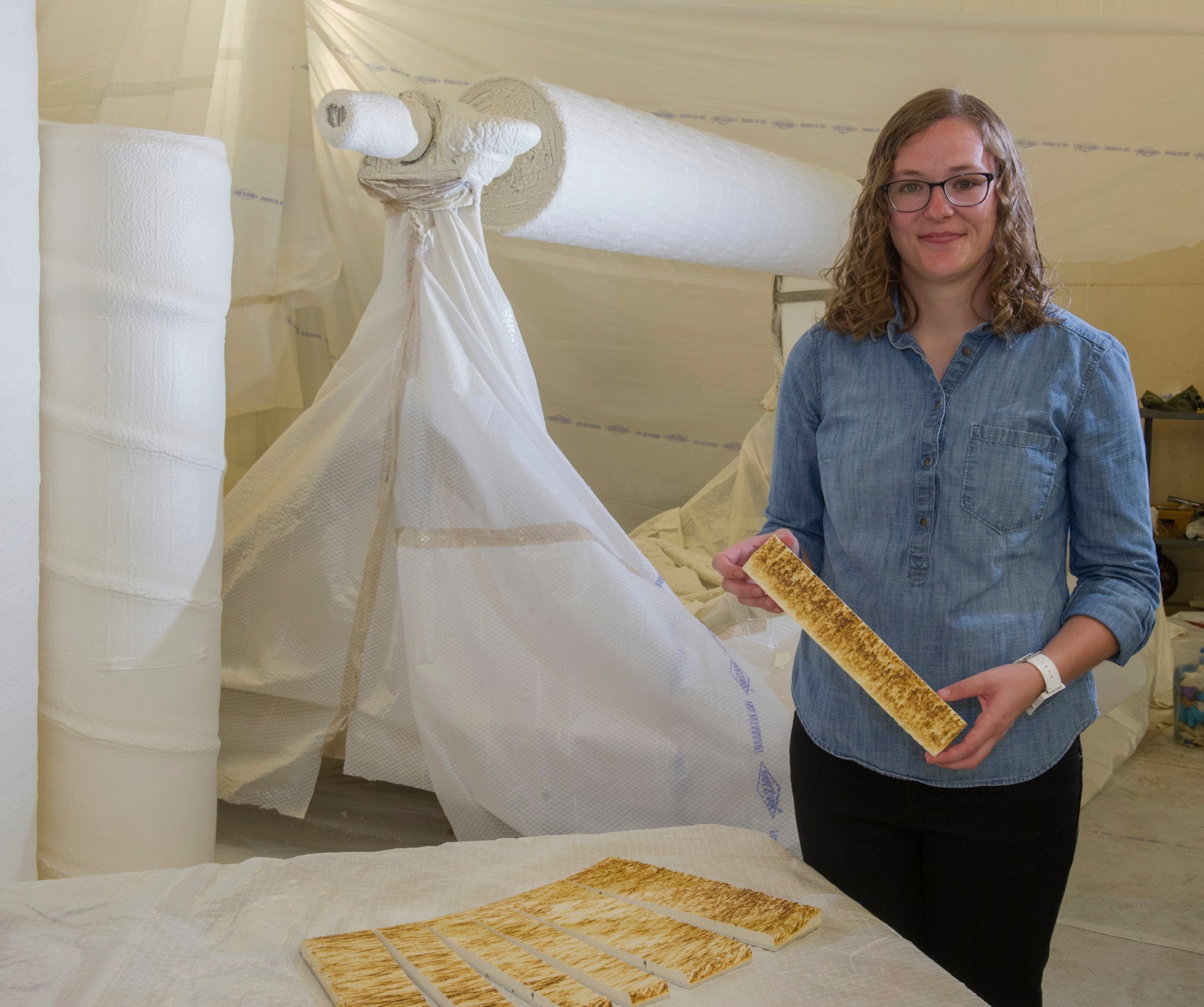
The rocket’s fuel is comprised of liquid hydrogen and liquid oxygen. Liquid hydrogen is cooled to -423 degrees Fahrenheit, and the liquid oxygen is cooled to -297 degrees. Insulation protects the outside of the core stage from ice build-up resulting from the subzero propellants inside the aluminum walls. Insulation also reduces heat flow to the propellants, hardware and flight systems during launch and atmospheric re-entry.
So, what kind of insulation materials can measure up for the world’s most powerful rocket? Engineers at NASA’s Marshall Space Flight Center are peeling back the layers to find out.
“NASA has developed new, more environmentally friendly insulation materials for future launch vehicles,” said Michael Frazier, nonmetallic materials branch chief at Marshall. ““The cryoinsulation materials for SLS are not only more environmentally compliant, but they are also just as efficient and lightweight as the previous generation of materials.”
Three types of foam have been developed and are being tested for SLS. The foams are all closed-cell materials, which means they are stronger and have greater resistance to heat flow and moisture. They also are non-ozone-depleting and flame resistant.
The different types of insulation are applied by varying methods — automatically by a robot; manually using a hand-held spray system; and hand mixed for pouring into molds. “With some parts of the rocket being so massive, like the core stage, robotic applications help reduce time and manpower with more control and continuous sprays,” said Amy Buck, SLS core stage insight lead at Marshall. The thickness of the insulation varies depending on the hardware, but it is typically about one inch.
Hundreds of 24-by-24-inch panels have been covered with the three types of foam for a variety of tests, which are being conducted by NASA and prime contractor Boeing, headquartered in Chicago, to qualify the insulation for the challenging environments SLS will experience before and during flight. Tests range from density measurements to exposing the foams to heating environments similar to those the SLS will see during ascent.
Qualification testing of all the foam systems is anticipated to be completed later this year. At that point, the materials will be ready to use on Exploration Mission-1 in late 2018. “There are some follow-on aging tests that we will run over the next few years, but those are just being done to ensure we don’t have any problems with long-term storage of the cured-foam products,” Frazier said.
So the next time you reach for a drink inside your cooler or shed the cold of winter in your home, think about another type of insulator that will be headed to deep space.
The initial SLS configuration, known as Block 1, will have a minimum 70-metric-ton (77-ton) lift capability. The next planned upgrade of SLS, Block 1B, will use a more powerful exploration upper stage for more ambitious missions with a 105-metric-ton (115-ton) lift capacity. Block 2 will add a pair of advanced solid or liquid propellant boosters to provide a 130-metric-ton (143-ton) lift capacity. In each configuration, SLS will continue to use the same core stage and four RS-25 engines.
For more information on SLS, click here.
Davidson, an ASRC Federal/Analytical Services employee, supports the Office of Strategic Analysis & Communications.
Jupiter’s North Pole Unlike Anything Encountered in Solar System
NASA’s Juno spacecraft has sent back the first-ever images of Jupiter’s north pole, taken during the spacecraft’s first flyby of the planet with its instruments switched on. The images show storm systems and weather activity unlike anything previously seen on any of our solar system’s gas-giant planets.
Juno successfully executed the first of 36 orbital flybys on Aug. 27 when the spacecraft came about 2,500 miles (4,200 kilometers) above Jupiter’s swirling clouds. The download of six megabytes of data collected during the six-hour transit, from above Jupiter’s north pole to below its south pole, took one-and-a-half days. While analysis of this first data collection is ongoing, some unique discoveries have already made themselves visible.
“First glimpse of Jupiter’s north pole, and it looks like nothing we have seen or imagined before,” said Scott Bolton, principal investigator of Juno from the Southwest Research Institute in San Antonio. “It’s bluer in color up there than other parts of the planet, and there are a lot of storms. There is no sign of the latitudinal bands or zone and belts that we are used to — this image is hardly recognizable as Jupiter. We’re seeing signs that the clouds have shadows, possibly indicating that the clouds are at a higher altitude than other features.”
One of the most notable findings of these first-ever pictures of Jupiter’s north and south poles is something that the JunoCam imager did not see.
“Saturn has a hexagon at the north pole,” said Bolton. “There is nothing on Jupiter that anywhere near resembles that. The largest planet in our solar system is truly unique. We have 36 more flybys to study just how unique it really is.”
Along with JunoCam snapping pictures during the flyby, all eight of Juno’s science instruments were energized and collecting data. The Jovian Infrared Auroral Mapper — JIRAM — supplied by the Italian Space Agency, acquired some remarkable images of Jupiter at its north and south polar regions in infrared wavelengths.
“JIRAM is getting under Jupiter’s skin, giving us our first infrared close-ups of the planet,” said Alberto Adriani, JIRAM co-investigator from Istituto di Astrofisica e Planetologia Spaziali, Rome. “These first infrared views of Jupiter’s north and south poles are revealing warm and hot spots that have never been seen before. And while we knew that the first-ever infrared views of Jupiter’s south pole could reveal the planet’s southern aurora, we were amazed to see it for the first time. No other instruments, from Earth or space, have been able to see the southern aurora. Now, with JIRAM, we see that it appears to be very bright and well-structured. The high level of detail in the images will tell us more about the aurora’s morphology and dynamics.”
Among the more unique data sets collected by Juno during its first scientific sweep by Jupiter was that acquired by the mission’s Radio/Plasma Wave Experiment — Waves — which recorded ghostly sounding transmissions emanating from above the planet. These radio emissions from Jupiter have been known about since the 1950s but had never been analyzed from such a close vantage point.
“Jupiter is talking to us in a way only gas-giant worlds can,” said Bill Kurth, co-investigator for the Waves instrument from the University of Iowa, Iowa City. “Waves detected the signature emissions of the energetic particles that generate the massive auroras which encircle Jupiter’s north pole. These emissions are the strongest in the solar system. Now we are going to try to figure out where the electrons come from that are generating them.”
The Juno spacecraft launched on Aug. 5, 2011, from Cape Canaveral and arrived at Jupiter on July 4, 2016. NASA’s Jet Propulsion Laboratory manages the Juno mission for the principal investigator, Scott Bolton, of Southwest Research Institute. Juno is part of NASA’s New Frontiers Program, which is managed at NASA’s Marshall Space Flight Center for NASA’s Science Mission Directorate. Lockheed Martin Space Systems, Denver, built the spacecraft. California Institute of Technology in Pasadena manages JPL for NASA.
NASA Approves 2018 Launch of Mars InSight Mission
NASA is moving forward with a spring 2018 launch of its InSight mission to study the deep interior of Mars, following final approval this week by the agency’s Science Mission Directorate.
The Interior Exploration using Seismic Investigations, Geodesy and Heat Transport — InSight — mission was originally scheduled to launch in March of this year, but NASA suspended launch preparations in December 2015 due to a vacuum leak in its prime science instrument, the Seismic Experiment for Interior Structure.
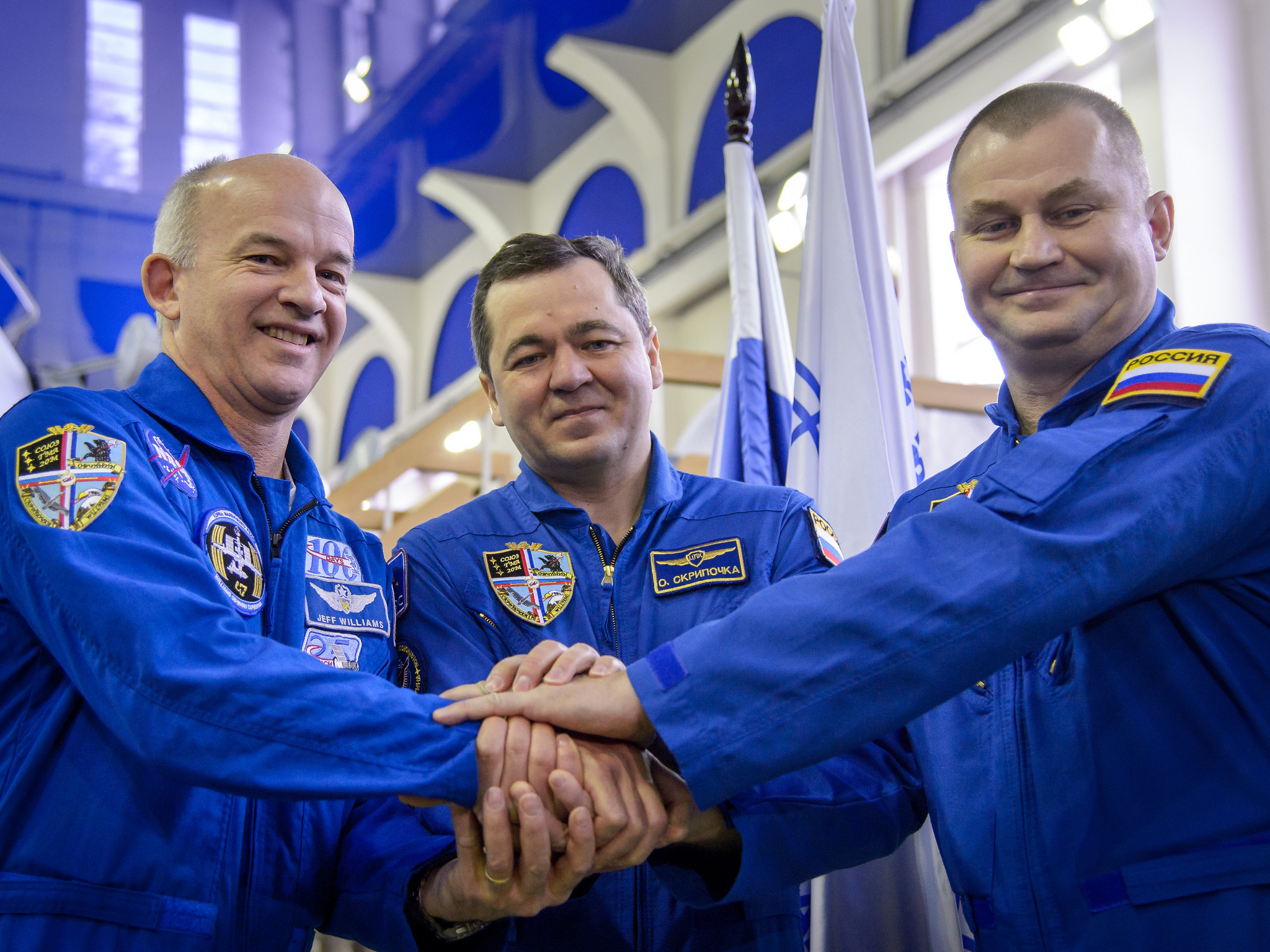
The new launch period for the mission begins May 5, 2018, with a Mars landing scheduled for Nov. 26, 2018. The next launch opportunity is driven by orbital dynamics, making 2018 the soonest the lander can be on its way.
“Our robotic scientific explorers such as InSight are paving the way toward an ambitious journey to send humans to the Red Planet,” said Geoff Yoder, acting associate administrator for NASA’s Science Mission Directorate. “It’s gratifying that we are moving forward with this important mission to help us better understand the origins of Mars and all the rocky planets, including Earth.”
The Seismic Experiment for Interior Structure instrument — designed to measure ground movements as small as half the radius of a hydrogen atom — requires a perfect vacuum seal around its three main sensors in order to withstand harsh conditions on the Red Planet. Under what’s known as the mission “replan,” NASA’s Jet Propulsion Laboratory will be responsible for redesigning, developing and qualifying the instrument’s evacuated container and the electrical feedthroughs that failed previously. France’s space agency, the Centre National d’Études Spatiales, will focus on developing and delivering the key sensors for SEIS, integration of the sensors into the container, and the final integration of the instrument onto the spacecraft.
The German Aerospace Center is contributing the Heat Flow and Physical Properties Package to InSight’s science payload.
NASA’s budget for InSight was $675 million. The instrument redesign and two-year delay add $153.8 million. The additional cost will not delay or cancel any current missions, though there may be fewer opportunities for new missions in future years, from fiscal years 2017-2020.
InSight’s primary goal is to help understand how rocky planets formed and evolved. Jim Green, director of NASA’s Planetary Science Division, said, “We’ve concluded that a replanned InSight mission for launch in 2018 is the best approach to fulfill these long-sought, high-priority science objectives.”
Jean-Yves Le Gall, president of the French space agency, added, “This confirmation of the launch plan for InSight is excellent news and an unparalleled opportunity to learn more about the internal structure of the Red Planet, which is currently of major interest to the international science community.”
The InSight Project is managed by JPL for NASA’s Science Mission Directorate. Lockheed Martin Space Systems, Denver, built the spacecraft. InSight is part of NASA’s Discovery Program, which is managed by NASA’s Marshall Space Flight Center.
NASA’s Record-breaking Astronaut, Crewmates Safely Return to Earth
NASA astronaut Jeff Williams returned to Earth Sept. 6 after his U.S. record-breaking mission aboard the International Space Station.
Williams and his Russian crewmates Alexey Ovchinin and Oleg Skripochka of the Russian space agency Roscosmos landed in their Soyuz capsule in Kazakhstan.
Having completed his fourth mission, Williams now has spent 534 days in space, making him first on the all-time NASA astronaut list.
“No other U.S. astronaut has Jeff’s time and experience aboard the International Space Station, from his first flight in 2000, when the station was still under construction, to present day where the focus is science, technology development and fostering commercialization,” said Kirk Shireman, the station’s program manager at NASA’s Johnson Space Center. “Jeff even helped prepare the space station for future dockings of commercial spacecraft under NASA’s Commercial Crew Program. We’re incredibly proud of what he has accomplished off the Earth for the Earth.”
Williams and fellow NASA astronaut Kate Rubins installed the first International Docking Adapter during a spacewalk on Aug. 19. Outfitted with a host of sensors and systems, the adapter’s main purpose is to connect spacecraft bringing astronauts to the station in the future. Its first users are expected to be Boeing’s CST-100 Starliner and SpaceX’s Crew Dragon spacecraft, now in development in partnership with NASA.
During his time on the outpost, Williams ventured outside the confines of the space station for a second spacewalk with Rubins to retract a spare thermal control radiator and install two new high-definition cameras.
Together, the space station crew members contributed to hundreds of experiments in biology, biotechnology, physical science and Earth science aboard humanity’s only orbiting laboratory.
Rubins, Russian cosmonaut Anatoly Ivanishin, and Takuya Onishi of the Japan Aerospace Exploration Agency, will operate the station for more than two weeks until the arrival of three new crew members.
Shane Kimbrough of NASA and cosmonauts Sergey Ryzhikov and Andrey Borisenko of Roscosmos are scheduled to launch Sept. 23 from Baikonur, Kazakhstan.
To keep up with the International Space Station, its research and crews, click here.
Visit NASA’s social media sites for the station to get breaking news, images and features from on Instagram and Twitter.
Four Questions with OSIRIS-REx Mission Manager Scott Bellamy
The first U.S. mission to travel to an asteroid, retrieve samples and return them to Earth is targeted for a Sept. 8 launch atop a United Launch Alliance Atlas V rocket from Cape Canaveral Air Force Station in Florida. This groundbreaking mission, several years in the making, is the Origins, Spectral Interpretation, Resource Identification, Security-Regolith Explorer, also known as OSIRIS-REx.
OSIRIS-REx is the third mission in the agency’s New Frontiers Program. NASA’s Marshall Space Flight Center manages New Frontiers for the agency’s Science Mission Directorate. Live coverage of the OSIRIS-REx mission launch will begin on NASA TV Sept. 8 at 3:30 p.m. and NASA.gov with the start of cryogenic tanking of the Atlas V rocket, and conclude approximately one hour after launch. The launch window for the OSIRIS-REx spacecraft is 6:05 to 8:05 p.m.
Scott Bellamy, mission manager at Marshall for OSIRIS-REx, sat down with us this week to answer several questions on the mission.
What’s the most exciting thing about the OSIRIS-REx mission to you?
This is absolutely awesome stuff! We’re going to go out and play TAG with an asteroid to bring a pristine sample back to Earth.! TAG is our acronym for the Touch-and-Go maneuver used to collect the sample.
OSIRIS-REx will be the first U.S. mission to bring an asteroid sample home. And it’ll be the largest collection from space since Apollo 17 returned lunar samples. It’s important that we go out to this particular asteroid, because twice a year, Bennu crosses Earth’s orbit. Nearly every six years, Bennu and Earth are at the same location in space at nearly the same time. This is an amazing opportunity to get up-close-and-personal with Bennu to study its makeup, its orbit and hopefully determine exactly how close we will come over the next century.
What are the science instruments on the spacecraft and what data do we expect?
Thanks to the collaboration of multiple agencies and academia, OSIRIS-REx boasts a wide variety of highly sophisticated instruments to conduct amazing science. This suite of instruments is used for remote sensing or scanning the surface of the asteroid. They will map Bennu and establish the composition of the asteroid, including the distribution of elements, minerals and organic material. These instruments, along with their contributing organizations, are:
OCAMS — OSIRIS-REx Camera Suite, developed by the University of Arizona, Tucson, is made up of the following:
- PolyCam — an 8-inch (20 centimeter) telescope that will be the first to image the asteroid from 1.24 million miles (2 million kilometers) away and provide high-resolution microscope-like images of the surface.
- MapCam — a camera that will map the surface of the asteroid in four colors.
- SamCam — a camera that will image (as fast as 1.6 seconds) the sample acquisition event and examine the sample collector to verify successful acquisition.
OLA — OSIRIS-REx Laser Altimeter, contributed by the Canadian Space Agency in Saint-Hubert, Québec, is a scanning LiDAR — Light Detection and Ranging — that will measure the distance between the spacecraft and Bennu’s surface and map the shape of the asteroid.
OTES — OSIRIS-REx Thermal Emission Spectrometer, provided by Arizona State University in Tempe, is an instrument that will provide mineral and temperature information by observing the thermal infrared spectrum.
OVIRS — OSIRIS-REx Visual and Infrared Spectrometer, delivered the by NASA’s Goddard Space Flight Center, is an instrument that will measure visible and infrared light from Bennu to identify mineral and organic material.
REXIS — Regolith X-Ray Imaging Spectrometer, provided by the Massachusetts Institute of Technology and Harvard University, both in Cambridge, is a student collaboration experiment that will observe the X-ray spectrum to determine what elements are present on Bennu’s surface and how abundant they are.
Asteroids are remnants of the original building blocks of our solar system, and can help us better understand the formation of the solar system over 4.5 billion years ago. For two years after the sample return (from late 2023-2025), the science team will catalog the sample and conduct the analysis needed to meet the mission science goals.
How did your NASA career path prepare you for this cool assignment as mission manager?
My time serving in the U.S. Air Force, in addition to my experience at NASA, both contributed to my experience before becoming the OSIRIS-REx mission manager.
Before joining NASA, I was an officer in the Air Force for 25 years. I began my NASA career at Marshall in January 2008 as the Air Force Liaison Officer. In a twist of good fortune, Robert Lightfoot, who was then Marshall’s deputy director, asked me to be the Ares V Core Stage Engine manager for the burgeoning project — it was a great opportunity — forever bonding me to the Marshall way of life. I retired from active duty in August 2009, but remained at Marshall supporting the early planning of NASA’s Space Launch System and eventually the SLS Liquid Engine Office, simultaneously supporting the Marshall Liaison of the Headquarters Human Exploration Office for Cross-Program Strategic Integration. I was delighted when I was offered the opportunity to join the Planetary Missions Program Office in July 2013 as the mission manager for OSIRIS-REx.
How will OSIRIS-REx help pave the way for future human missions to Mars?
Missions like OSIRIS-REx help us better understand the hazards and resources in space. It will help us gather information we will need to prepare for human missions to Mars and beyond with SLS, which will allow human travel to deep space destinations.
NASA Celebrates 50th Anniversary of Original Star Trek TV Series
NASA will celebrate the 50th anniversary of the original Star Trek television series that premiered in September 1966. The series captured the public’s imagination with the signature phrase, “To boldly go where no one has gone before,” and inspired countless scientists and engineers to fall in love with the infinite possibilities of space exploration.
While the TV show featured large ships voyaging to stars far away on five-year missions, NASA was only beginning to stretch humanity’s presence beyond Earth. When Star Trek premiered on Sept. 8, 1966, astronauts Pete Conrad and Richard Gordon were four days from launch aboard Gemini XI, a three-day mission that would reach an altitude of less than 200 miles.
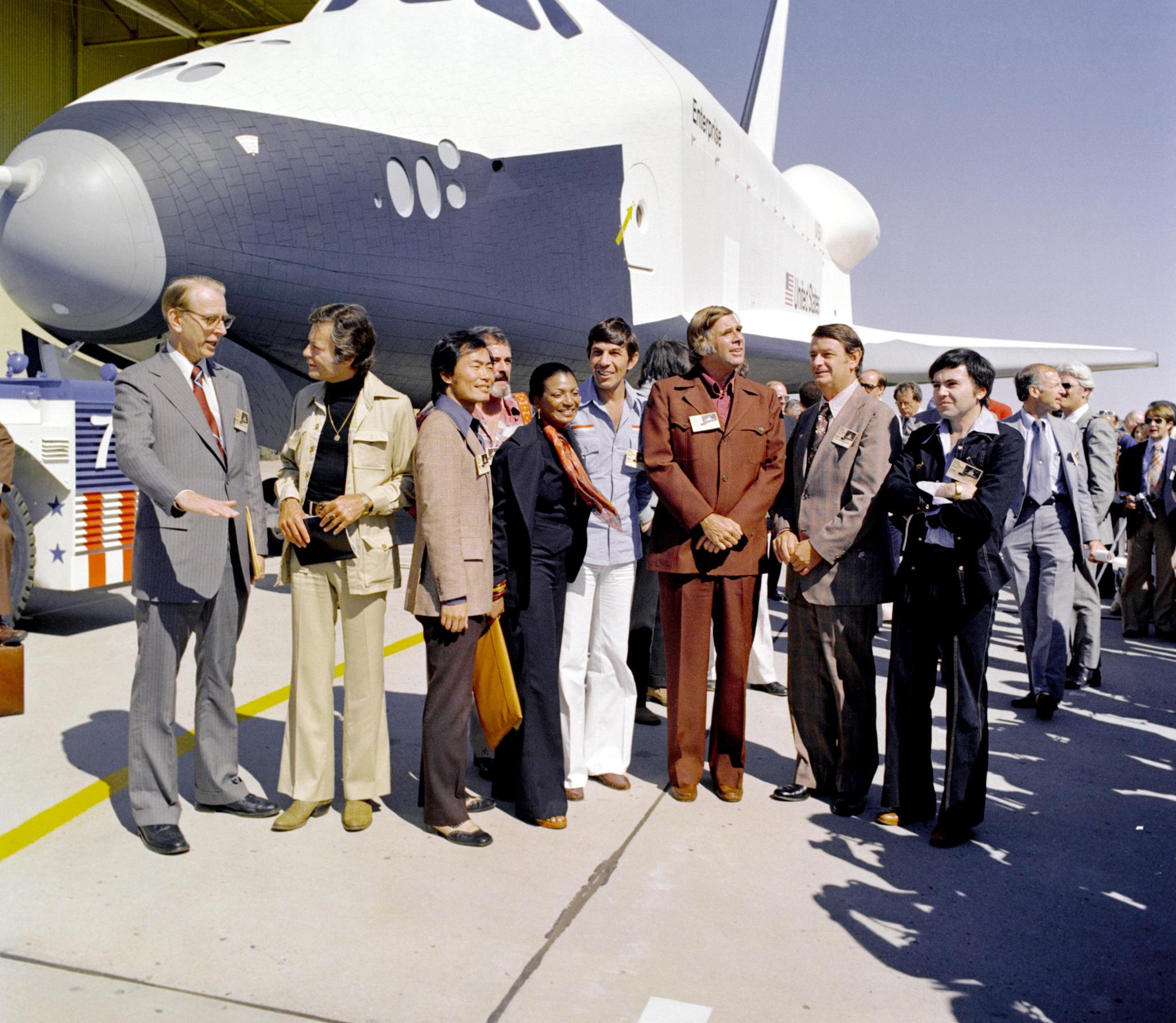
From left to right they are: NASA Administrator Dr. James D. Fletcher; DeForest Kelley, who portrayed Dr. “Bones” McCoy on the series; George Takei (Mr. Sulu); James Doohan (Chief Engineer Montgomery “Scotty” Scott); Nichelle Nichols (Lt. Uhura); Leonard Nimoy (Mr. Spock); series creator Gene Roddenberry; U.S. Rep. Don Fuqua (D.-Fla.); and, Walter Koenig (Ensign Pavel Chekov).
NASA is mourning the passing today, Feb. 27, 2015, of actor Leonard Nimoy, most famous for his role as Star Trek’s Vulcan science officer Mr. Spock. The sci-fi classic served as an inspiration for many at NASA over the years, and Nimoy joined other cast members at special NASA events and worked to promote NASA missions, as in this 2007 video he narrated before the launch of the Dawn mission to the asteroid belt. Nimoy also was there for the 1976 rollout of the shuttle Enterprise, named for the show’s iconic spacecraft. Credits: NASA
Beyond Gemini, NASA was working hard in other areas to understand space. In April 1966, NASA launched the first Surveyor mission to the moon, to collect scientific data and help ground teams determine where on the moon Apollo missions would land. The first commercial communications satellite, Intelsat I, had gone into orbit a year before. Earlier, spacecraft had flown by Venus and Mars. And NASA had already begun its Earth science program with the first series of weather satellites.
Star Trek moved beyond NASA’s limited horizon at, well, warp speed. In three seasons, it reached out beyond Earth to encounter Vulcans, Romulans and Klingons, not to mention tribbles and Harry Mudd. When the show ended after three seasons, NASA was still six weeks from landing astronauts on the moon, but Star Trek had firmly implanted the idea of travel to the stars in the collective imagination.
Cut, as they say on TV shows, to 1976. NASA is rolling out a test version of its new spacecraft, which will launch like a rocket, carry astronauts into orbit and then land like a glider. Most of its parts, including the orbiter, will be re-used. NASA had planned to call it the Constitution, but a letter-writing campaign by Star Trek fans persuaded the White House to direct NASA to name it Enterprise, after Star Fleet’s most famous ship. Some even believe Star Trek influenced NASA to call its new vehicle a shuttle.
Since then Star Trek and NASA’s paths through space have intersected several times. Actress Nichelle Nicholls, who played Lt. Uhura and was one of the first African-American actors to play a major part on an American primetime series, helped NASA recruit African-Americans to become astronauts in the 1970s. Leonard Nimoy, who played Mr. Spock, narrated the film Destiny in Space, an IMAX production that included footage shot by astronauts as they repaired the Hubble Space Telescope.
Several astronauts have said Star Trek inspired them to want to go into space, and Edward Weiler, former chief scientist for the Hubble Space Telescope, said the show made him want to study science. Several astronauts have appeared in Star Trek on TV or in films, NASA officials have served as consultants to the films, and Hubble images have been used on Star Trek: Voyager. In recognition of the way Star Trek inspired people around the globe, NASA awarded its Distinguished Public Service Medal posthumously to Gene Roddenberry, the show’s founding producer.
For more information about intersections between NASA and Star Trek click here.
This Week in NASA History: President Eisenhower Formally Dedicates Marshall Center — Sept. 8, 1960
This week in 1960, President Dwight Eisenhower visited Huntsville to formally dedicate NASA’s Marshall Space Flight Center. The center was named in honor of Gen. George C. Marshall, Eisenhower’s wartime colleague and the founder of the famous Marshall Plan for European recovery after World War II. Here, Eisenhower talks with Wernher von Braun, Marshall’s first center director, in front of the core stage of a Saturn I rocket, which was built at Marshall. The NASA History Program is responsible for generating, disseminating and preserving NASA’s remarkable history and providing a comprehensive understanding of the institutional, cultural, social, political, economic, technological and scientific aspects of NASA’s activities in aeronautics and space. For more pictures like this one and to connect to NASA’s history, visit the History Program’s webpage. (NASA)
A New Galaxy, Jupiter Images and New Horizons Updates are Featured on ‘This Week @NASA’
The discovery of a distant galaxy, best-ever images of Jupiter and a mission update of the New Horizons spacecraft are featured in the latest edition of “This Week @NASA,” a weekly video program broadcast nationwide on NASA-TV and posted online.
A record-breaking galaxy cluster was discovered using data from NASA’s Chandra X-ray Observatory and other telescopes. The galaxy cluster is located about 11.1 billion light years from Earth and may have been imaged shortly after it was born — a brief, but important stage of cluster evolution never seen before. This cluster is remarkable because of elevated star formation in galaxies near its center, averaging a rate equivalent to more than 3,000 a year.
NASA’s Juno spacecraft successfully completed its first and closest of 36 orbital flybys of Jupiter on Aug. 27. Zipping about 2,600 miles above the gas giant, scientists recorded the highest-resolution views yet of the Jovian atmosphere, as well as the first glimpses of Jupiter’s north and south poles. Juno’s mission to gather data on Jupiter’s polar regions is targeted to last until February 2018.
On Aug. 31, NASA Headquarters hosted a program titled, “New Horizons Mission to Pluto and Beyond.” The event featured a presentation from Alan Stern — principal investigator of NASA’s New Horizons mission — about the spacecraft’s historic encounter with the Pluto system in 2015 and what’s planned for the extended mission in the Kuiper Belt. The spacecraft is on its way to a New Year’s Day encounter in 2019 with an ancient object considered to be an early building block of the solar system.
The Chandra X-ray Observatory program is managed by NASA’s Marshall Space Flight Center for the agency’s Science Mission Directorate. The New Horizons and Juno missions are part of the New Frontiers Program, which is also managed by Marshall.
View this and previous episodes at “This Week @NASA” or at https://www.youtube.com/user/NASAtelevision.
Obituaries
Kathleen G. Lundy, 72, of Huntsville, died Aug. 26. She retired from the Marshall Center in 2011 as a management support assistant. She is survived by her husband, Rusty Lundy.
Virginia D. Scott, 91, of Huntsville, died Aug. 31. She retired from the Marshall Center in 1980 as a traffic management specialist.
Jack M. Carroll, 91, of Huntsville, died Sept. 3. He retired from the Marshall Center in 1980 as an engineering technician.



























